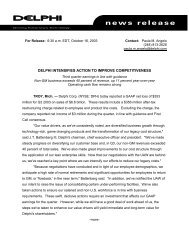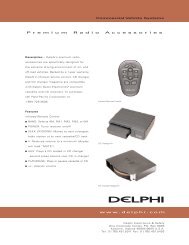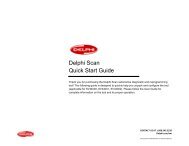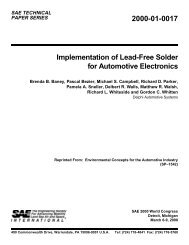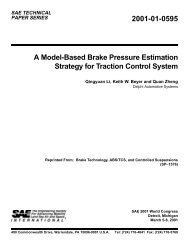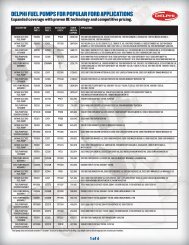2003-01-0954 Safety Belt Fit, Comfort, and Contact ... - Delphi
2003-01-0954 Safety Belt Fit, Comfort, and Contact ... - Delphi
2003-01-0954 Safety Belt Fit, Comfort, and Contact ... - Delphi
You also want an ePaper? Increase the reach of your titles
YUMPU automatically turns print PDFs into web optimized ePapers that Google loves.
Mean Pressure (g/cm2)<br />
.09<br />
.08<br />
.07<br />
.06<br />
.05<br />
.04<br />
.03<br />
1.00<br />
2.00<br />
3.00<br />
4.00<br />
5.00<br />
Seat <strong>Belt</strong> Segments<br />
6.00<br />
7.00<br />
8.00<br />
D-ring in Y-axis<br />
Inside<br />
Middle<br />
Outside<br />
Figure 5. Mean Pressure Distribution as a Function of<br />
"D"-ring Location in Inboard-Outboard Direction<br />
Mean Pressure (g/cm2)<br />
.08<br />
.07<br />
.06<br />
.05<br />
.04<br />
.03<br />
Inside<br />
Middle<br />
D-ring in Y-axis<br />
Outside<br />
D-ring in X-axis<br />
Foremost<br />
Middle<br />
Rearmost<br />
Figure 6. Mean Pressure Distribution as a Function of<br />
"D"-ring Locations in Both Fore-Aft <strong>and</strong> Inboard-Outboard<br />
Directions.<br />
SUBJECTIVE RATING ON CONTACT PRESSURE AND<br />
SEAT BELT FIT<br />
ANOVA on subjective rating of contact pressure (see<br />
Appendix ANOVA Table 4) shows that the seat back<br />
angle, D-ring location in both fore-aft <strong>and</strong> inboardoutboard<br />
directions are still statistically significant. This<br />
outcome complies with the results from the ANOVA on<br />
objective measurements of contact pressure <strong>and</strong><br />
distribution. Conversely, the D-ring location in height<br />
adjustment is not a significant factor, which means that it<br />
has a little impact on sensed seat belt pressure in terms<br />
of occupant’s subjective feeling. However, in ANOVA on<br />
subjective rating regarding seat belt fit/routing; all of the<br />
4<br />
variables, including seat back angle, D-ring in fore-aft,<br />
lateral, <strong>and</strong> vertical directions, are statistically significant.<br />
This finding indicates that the height adjustment for seat<br />
belt upper attachment point is essential to achieve a better<br />
seat belt fit/routing <strong>and</strong> to help reduce the risk of seat belt<br />
rubbing the neck or slipping off the occupant’s shoulder.<br />
However, it cannot improve the contact comfort by<br />
reducing the contact pressure. Figure 7 displays the<br />
mean value/ trend of occupants’ comfort rating on seat<br />
belt fit with respect to the seat back angle <strong>and</strong> D-ring<br />
location on Z-axis. There is a significant difference in<br />
comfort rating for different levels of D-ring height, which<br />
support the results from ANOVA table (Table 4 in<br />
Appendix).<br />
As a general observation from the experiment, some<br />
participants who were in the low height <strong>and</strong> low BMI<br />
category complained about the seat belt rubbing their<br />
necks. Although it cannot be generalized due to the small<br />
number of participants, a similar complaint was received<br />
from the participants who were at the higher end of the<br />
BMI <strong>and</strong> height scale combination.<br />
Mean Pressure (g/cm2)<br />
2.8<br />
2.6<br />
2.4<br />
2.2<br />
2.0<br />
1.8<br />
0 degree<br />
10 degree<br />
Seat Back Angle<br />
20 degree<br />
D-ring in Z-axis<br />
Figure 7. Subjective Rating on Seat <strong>Belt</strong> <strong>Fit</strong> as a<br />
Function of Seat Back Angle <strong>and</strong> "D"-ring Locations in<br />
Different Height Levels<br />
Note: <strong>Comfort</strong> Rating Scale (1-5)<br />
1: Slipping off the shoulder<br />
3: Just right<br />
5: Rubbing the neck<br />
DISCUSSION<br />
In this study, height <strong>and</strong> BMI data of all participants were<br />
recorded as the between-subject variables. However, the<br />
results of ANOVA with repeated measurements for each<br />
participant show that body height <strong>and</strong> BMI are not<br />
statistically significant. Hypothetically, body height <strong>and</strong><br />
High<br />
Low



